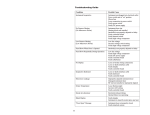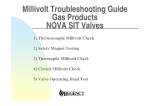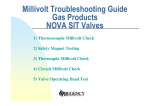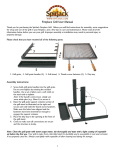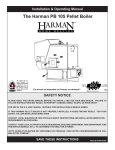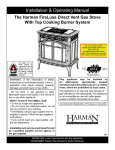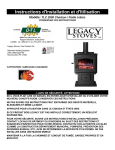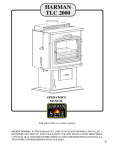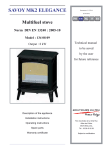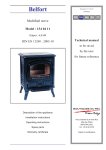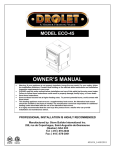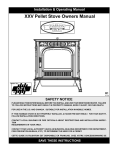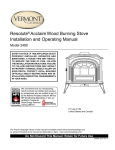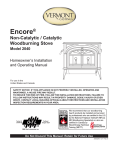Download The harman Exception woodburning Fireplace Insert
Transcript
Installation & Operating Manual The Harman Exception Woodburning Fireplace Insert R10 “Ce manuel est disponible en Français sur demande” SAFETY NOTICE Please read this entire manual before you install and use your new room heater. Failure to follow instructions may result in property damage, bodily injury, or even death. FOR USE IN THE U.S. AND CANADA. not SUITABLE FOR INSTALLATION IN MOBILE HOMES IF THIS HARMAN STOVE IS NOT PROPERLY INSTALLED, A HOUSE FIRE MAY RESULT. FOR YOUR SAFETY, FOLLOW INSTALLATION DIRECTIONS. CONTACT LOCAL BUILDING OR FIRE OFFICIALS ABOUT RESTRICTIONS AND INSTALLATION INSPECTION REQUIREMENTS IN YOUR AREA. Contact your local authority (such as municipal building department, fire department, fire prevention bureau, etc.) to determine the need for a permit. Cette guide d'utilisation est disponible en francais. Chez votre concessionnaire de Harman Stove Company. save these instructions. R1 R7 R6 Exception F200 Wood Insert INDEX Specifications 3 Operation 4 Building a Fire 6 Maintenance 8 Installation Parts Diagram 10 Warranty 16 14 Please read this entire manual before you install and use your new wood burning insert. Failure to follow instructions may result in property damage, bodily injury, or even death. Harman Stove Company 352 Mountain House Road Halifax, PA 17032 Exception F200 Wood Insert Specifications - Harman Exception, Model F200 48" 28.506" 6.391" 22.25" 23.8" 34" 17.533" 10.777" 19.072" 9.19" Weight 425 lbs Flue Size 6 inch Log Length Recommended 18" with 20" Max Heating Capacity 1500 to 2000 sq. ft. Average Emissions 4.4 Grams Per Hr. Emissions on Low 2.25 Grams Per Hr. Blower Size 100 cfm variable speed The Harman F200 meets the U.S. Environmental Protection Agency’s emission limits for wood heaters sold after July 1, 1990. NOT FOR USE IN MOBILE HOMES. SAFETY NOTICE: IF THIS HARMAN EXCEPTION MODEL F200 WOOD INSERT IS NOT PROPERLY INSTALLED. A HOUSE FIRE MAY RESULT. FOR YOUR SAFETY, FOLLOW THE INSTALLATION DIRECTIONS CONTACT LOCAL BUILDING OR FIRE OFFICIALS ABOUT RESTRICTIONS AND INSTALLATION INSPECTION REQUIREMENTS IN YOUR AREA. Exception F200 Wood Insert Operation General Considerations Draft Before you install and operate your Exception woodburning insert, please read the entire contents of this manual. Pay particular attention to the explanation of draft and its effect on insert performance in the Installation section. By following the installation and operating guidelines, you will ensure proper draft and gain maximum efficiency and enjoyment from your insert. Fuel Your Exception burns wood very efficiently. Here are some guidelines concerning log size and moisture content that will help you obtain the best performance. Select hardwoods if possible, as they are heavier and contain more heating capacity (BTU’s) per load than do softwoods. Wood should be split and stored under cover for “seasoning”-a year is recommended. Your insert is not an incinerator-do not burn garbage, painted or treated wood, plastic, or other debris. Keep the area around the insert free from clutter. Keep all combustibles, including fuel, beyond the coderequired clearance distance (48" or 1215 mm in the U.S., 1525 mm or 60" in Canada). Never store fuel in front of the insert where it could interfere with door operation, safe loading, and ash removal. Do not burn garbage or flammable fluids such as gasoline, naptha, or engine oil. The Insert Doors Your insert has a large glass-paneled door for loading and fire viewing. To open the glass door, turn the handle clockwise and pull out; to close the door, return the handles to an open, 9 o'clock, position. Push the door closed, while turning the handle counterclockwise to the 6 o'clock position. If the latch on your Exception door needs adjustment, follow the instructions given in the Maintenance section of this manual. FOR USE IN THE U.S. AND CANADA The door must be closed while the insert is in normal operation, and the gaskets routinely examined for wear and replaced when necessary. Good door seals are important for maintaining control of the insert. Operating the insert with the door inadequately sealed, could create a serious over-firing condition (discussed later in this section). The glass used in your Exception is manufactured to exact standards to withstand the high heat of the fire. Like all glass, it must be treated with common sense and care. Never abuse the glass by slamming the door shut or striking the glass with a heavy object. If the glass is broken or damaged, do not operate the insert until it has been replaced (See instructions in the Maintenance section.) Operating As A Fireplace To operate as a fireplace, open the damper and keep it open. Next, open the door and place the optional screen (part number 3-40-727336) over the door opening. Check for smoke spillage into the room. If smoke is escaping into the room, remove the screen and close the door. Always wear gloves when placing or removing the screen. Never leave the unit unattended with the door open. Andirons The andirons keep the fuel from coming in direct contact with the glass, and keep hot coals and embers from spilling out while reloading. Never build a fire directly against the glass. Do not use a grate or elevate the fire. Build the fire directly on the insert's brick hearth. Cette guide d'utilisation est disponible en francais Chez votre concessionnaire de Harman Stove Company SAFETY NOTICE: IF THIS HARMAN EXCEPTION MODEL F200 INSERT IS NOT PROPERLY INSTALLED, A HOUSE FIRE MAY RESULT. FOR YOUR SAFETY, FOLLOW INSTALLATION DIRECTIONS. CONTACT LOCAL BUILDING OR FIRE OFFICIALS ABOUT RESTRICTIONS AND INSTALLATION INSPECTION REQUIREMENTS IN YOUR AREA. Exception F200 Wood Insert The Combustion Process Combustion in your Harman Exception wood insert is controlled very precisely. During a wood fire, primary combustion air enters the bottom of the insert, is directed up to the top of the load door and then down past the glass, finally entering the combustion chamber. Secondary combustion air enters the bottom of the insert and is delivered directly to the afterburner behind the firebox, where it provides the additional oxygen required for clean burning. During combustion, burning proceeds through several stages - an initial evaporation stage, where moisture is released from the wood; a stage where volatile gases containing much of the wood’s heating capacity are released and burned; and a charcoal stage, where the remaining charcoal burns to release the additional heat available. What is left after this final stage is ash. Within the firebox, two or more of these stages are generally occurring at once. Controls Two important controls - the damper handle and the air control lever regulate the operation and output of the insert. Move the damper handle to the forward position (approximately 3") and the handle automatically opens the bypass damper. In this mode of operation the combustion gases go directly from the main combustion chamber to the flue collar and exit into the chimney. NOTE: The bypass damper must be open for smokeless loading. Air Control. The air control rod is located directly below the ash lip on the left side of the insert. Using this lever you will be able to vary the amount of air delivered to the fire, creating a range of heat outputs. The low heat output setting is with the control pushed all the way in. The high setting is with the control pulled all the way out. Do not, under any circumstances, alter the configuration or operation of the air control rod. Damper Open Damper Closed Exception F200 Wood Insert Building and Maintaining the Fire Set the air control lever at the maximum heat output setting, all the way pulled out. Open the bypass damper by pulling the handle forward (approximately 3"). The convection blower should be off for the first five minutes after a reload. Do not use chemicals or fluids to start the fire. Never use gasoline, gasoline-type lantern fuel, kerosene, charcoal lighter fluid, or similar liquids to start or “freshen up” a fire in this heater. Keep all such liquids well away from the heater while it is in use. Reference Notches Medium High Medium Low Low Air Control shown in the full open position which is to be used only for start-up and refueling Build a bed of paper and kindling; place several 1 " - 2" (25 mm - 50 mm) split pieces of dry wood on top, followed by a few 2"- 3" (50 mm - 80 mm) split pieces. Ignite the paper. Allow the fire to burn until a good charcoal bed, 2"-3" (50 mm - 80 mm) is formed; close the bypass damper by pushing the handle "in" all the way back. (You may need to leave the load door open a crack to get the blaze going properly, but never leave the insert unattended with the door open.) Add more wood to create a deeper charcoal base (3"-4", or 80mm - 100mm thick); remember to open the bypass damper when loading. This will allow the exhaust gases to pass directly into the flue outlet and reduce smoke spillage during refueling. Once the charcoal bed is established you may add a full load of dry wood. After adding the fuel, leave the damper open and the air setting at maximum for 10 to 15 minutes; close the damper and allow the air setting to remain on high for an additional 5 to 10 minutes. Adjust the air lever and blower speed for the desired heat output. Reloading. Once you have prepared and maintained a thick charcoal bed, you should be able to reload the insert, allow some open damper burning at the maximum air setting, close the damper and reset the air control in about five minutes. Blower. Air Control Rod Shown In The Medium Low Position. To regulate the speed of the convection blower, adjust the control from low to high by turning the knob located on the blower cord. The blower speed should be matched to the air control lever setting. When the air setting is low, the blower should always be at the minimum setting (corresponding to a blower speed of 750 RPM.) At higher settings, above Exception F200 Wood Insert the first notch, the blower may be set to your desired comfort level. Be sure that the blower cord does not run under, over, above or in front of the insert. The following guidelines for air settings can be used for wood burning; as you become familiar with your insert, you will know which settings best heat your home. Minimum Burn Rate - air control fully to right. Medium-Low Burn Rate - air control pulled 1" out to the second notch. Medium-High Burn Rate - air control pulled out to the fourth notch. This setting may be used to burn wood that is damp in order to keep it burning, but will consume seasoned, dry wood too fast. High Burn Rate - air control fully pulled out. This setting is for refueling and starting a fire. Continuous burning at this setting will cause premature failure of consumable parts such as the afterburner hood and firebricks. Note: At minimum burn rates the glass may get dirty but will clean itself off again at higher burn rates. After Burner Viewport. This is a small ceramic glass window in the back of the firebox. This window allows you to see the Afterburner Combustion System in action. This glass may smoke up under some conditions but will burn off again. It is OK if this glass is not totally clean. Operating as a Fireplace. The F200 is tested and approved to be burned with the front load door open and the damper open. In this mode of operation you get a true fire sound as well as appearance. Due to the crackling and popping of burning wood it is necessary to place the optional screen over the door opening. This prevents sparks from entering the room just like a screen over a fireplace. The insert is hot while in operation. Keep children, clothing and furniture away. Contact may cause skin burns. Overfiring Avoid overfiring your insert. Overfiring is a potentially hazardous situation which can lead to overheating of combustible materials, damage to the insert, and in extreme cases, cause a fire. Overfiring is caused by: 1. Too much air flowing through the insert too quickly. 2. You may have positioned the primary air control lever too far to the left. 3. You may have, inadvertently, left the damper open. 4. Not keeping up with routine maintenance, such as checking door gaskets for wear. Overfiring results in excessive fuel consumption, and may cause parts of the insert to glow red. If you notice signs of overfiring, reduce the air supply to the fire, and review the Maintenance section in this manual. Never leave the insert unattended with the door open. Overfiring may result. In the event of a chimney fire, call your local fire department; make sure everyone is safely out of the house. Reduce the air intake of the insert as much as possible using the air control lever; close the bypass damper to further restrict air flow. Do not throw water on the fire; this can cause insert damage and create an even more dangerous situation. Have your chimney professionally cleaned and inspected before resuming burning in your insert. Removing and Disposing of Ashes. Before opening the door to remove the ashes, open the bypass damper. Wearing heavy protective gloves, remove ashes from the fire chamber periodically with a small shovel. Close the door before taking the ashes outside for safe disposal. A good time to empty the ashes is before loading. This ensures that the ashes will be cold and safer to handle than directly after poking the ashes down or tending the fire. Never let the ashes build up to over 2" in depth. Excessive ash buildup can prevent proper venting of exhaust gases. Ashes should be placed in a metal container with a tight fitting lid. The closed container of ashes should be placed on a noncombustible floor or on the ground, well away from all combustible materials, pending final disposal. If the ashes are disposed of by burial in soil or otherwise locally dispersed, they should be retained in the closed container until all cinders have thoroughly cooled. Never use the ash disposal container for other trash. Wood ash can be added to your garden or compost. Curing Paint. As you begin to operate your insert at higher temperatures, you will notice a “hot” or unpleasant smell; this is just the paint going through the curing process, and will disappear after a few fires. Exception F200 Wood Insert Maintenance Like all fine equipment, your Exception requires some routine maintenance and inspection. Follow the guidelines in this section to guarantee safe and efficient operation. The Insert Surface The insert’s exterior surface should be dusted periodically with a soft cloth. For more thorough cleaning, wait until the insert is cool before using a damp cloth to clean any blemishes. The Door The gold plated front door should never be buffed or polished. Abrasive cleaners and metal polishes will remove the plating and therefore should never be used. If the door needs to be cleaned, wait until the insert is completely cool, then use a sponge, soap and water to gently remove dirt and stains. Before relighting the insert, remove all soap residue and wipe dry. Controls To avoid a rust buildup on the inner surfaces of the controls, work the controls back and forth several times during the summer, or any prolonged period when you are not using your insert. Glass Gasket Glass Hold Down Clips and Bolts The Fire Chamber The inside of the fire chamber should be examined for damage to the refractory lining material, Afterburner hood and Afterburner glass. If any of these parts have been damaged, replace them with Harman Stove Company replacement parts. Glass - Replacement If the insert’s glass is cracked or broken, you must replace it before operating your insert. Remove pieces carefully. Replace the glass only with Harman Stove Company replacement glass; do not use substitutes. To replace the glass panel, you will need to remove the door. To do this, open the door, lift it straight up and place it on a soft surface. Carefully remove damaged glass, gasket material, and hold down clips (set aside). Referring to the diagram, note how the various components of the door system fit together. Lay the load door face down on the soft surface. Install the self adhesive 1/4"” gasket material around the front face of the glass. Note: This glass has a special IR coating on one side. This coating must be to the outside of the insert. The coated side has a label on it. Do not remove the label before installing the glass. Remove label before burning the unit. If the label has been removed, you can determine which side has the coating by using an OHM meter. The side with the coating will show resistance. Set the glass panel and gasket gently onto the door. Install the hold down clips and tighten with bolts as shown. Reinstall door on insert. Door Glass - Cleaning Sometimes it will be necessary to clean accumulated ash from the glass surface; allowing this ash to remain on the glass for long periods can result in “etching” due to the acidity of the ash. Any creosote which accumulates on the glass should burn off during your hot fires. Never clean the glass while it is hot, and do not use abrasive substances. Wash the surface with cool water, and rinse thoroughly. You may wish to use a nonabrasive cleaner specifically designed for use on insert glass. In any case, dry thoroughly before relighting your insert. Exception F200 Wood Insert Gaskets Gaskets are used at strategic positions when building the Harman Exception for controlling the path that incoming and outgoing air and gases take through the insert. You must check these gaskets from time to time, and replace them when necessary. The gaskets are made of fiberglass of different sizes (obtainable from Harman Stove Company) and are fixed in place with a high temperature gasket cement. To change a gasket, first remove the worn fiberglass and clean the area with a wire brush. Also clean any other surfaces that come into contact with the gasket. Place a small bead of cement in the area under the gasket, then press new gasket material into the channel; do not overlap the ends. Seat the gasket firmly by applying pressure when possible; for example, after changing the door gasket, close the door. Allow the cement to dry before using your insert. Gaskets are located on the door to provide airtight closure and between the damper and the damper frame. Handle The handle on the front door of your Exception is attached to a threaded shaft. After a period of time, you may find that the front door does not close as firmly as when your insert was new. This is due to a natural compression of the gaskets. To tighten the seal, open the door and rotate the handle one full turn counterclockwise or bend the latch plate on the insert body. The Chimney System Creosote Formation And Need For Removal When wood is burned slowly, it produces tar and other organic vapors, as well as soot, which combine with expelled moisture to form creosote. The creosote vapors condense in the relatively cool chimney flue (associated with a slow burning fire). As a result, creosote accumulates on the flue lining. When ignited, this creosote can produce an extremely hot fire. The afterburner on the Exception cuts creosote to almost nothing when properly burned with dry seasoned wood. The chimney should be inspected at least once every two months during the heating season to see if any creosote buildup has occurred. Checking your chimney and chimney connector more frequently, especially while you are getting used to your insert, is recommended. To inspect this system, let the insert cool. Using a flashlight and mirror, check the interior of the chimney connector, and the chimney itself. If a significant layer of creosote or soot has accumulated (1/8"” or 3 mm) it should be removed to reduce the risk of a chimney fire. To clean deposits from the surface of the connector, use a stiff wire brush after dismantling the connector assembly. To clean the chimney, use a specially designed brush sized to fit your particular flue opening, or call an established chimney cleaning service. At the end of the heating season, perform a thorough examination of your chimney system, and have it repaired if necessary. Do not burn any fuel other than wood, such as charcoal, which can cause increased carbon monoxide production or overfiring. Never use highly volatile substances in your insert, such as gasoline, which could cause an explosion. When solid fuels are burned completely, they produce water and carbon dioxide. However, in long slow burns, a substantial amount of carbon monoxide may be produced. If allowed to build up, carbon monoxide (which is odorless) can prove fatally poisonous. Proper ventilation and draft will prevent this from happening. If you smell smoke, increase the air control lever setting, and thoroughly ventilate your dwelling. During future burns, be careful not to overload the insert with fuel, so you will not be tempted to constantly operate at a low air control setting. Other causes of poor ventilation or draft are icing, exhaust fans, and room air starvation. If your insert is sluggish and you get an occasional odor, check these possibilities and increase the air flow in your home. Proper Ventilation Always provide a source of fresh air to the room when the insert is operating. Blower The blower on your Harman Exception insert requires very little maintenance. You should, however, keep the air inlet and the motor free of dust. Assembly Installation Exception F200 Wood Insert Top Wing Parts To Be Assembled Right Wing Right Corner Trim Damper Control Blower Variable Speed Control Left Wing Blower Air Adjuster Rod Base Cover Left Corner Trim Ash Lip With Gold Trim Assembling The Corner Panels Assembling The Wings Top Wing Bolts Damper Handle Damper Rod Side Wing Bolts Corner Panel Bolt Andirons Corner Panel Using a 5/32 allen wrench, install left and right side wings with 1/4-20 button head bolts. Next install top wing use the same size bolts. Install andirons with 5/16 bolts and washers. Install the corner panels using an 5/32 allen wrench and a 1/4-20 button head bolt. The left corner panel must slide over the damper rod. Install the damper handle after the left corner panel has been fastened. 10 Exception F200 Wood Insert Warning: Do not install in sleeping room. In all installations, the area under and around the insert must be protected from falling ash and live coals. This protector must be of noncombustible material, and positioned as shown in the accompanying illustration. The guidelines for the floor protection are in both USA and CANADA: 8"(200mm) to each side of the door opening, and: In USA: 16"USA 18"Canada Wall 8" Floor Protection Floor Protector 22" 559mm In CANADA: Mantel 16" of non-combustible material in front of the door opening. If the floor surface is 0" - 4 1/2" (114mm) below the insert base, 18"(450mm) of 1/2"(12.7mm) thick, k=.84 thermal protection is required in front of the door opening. (2) If the floor surface is greater than 4- 1/2"(114mm) below the base of the insert, 18"(450mm) of non-combustible material in front of the door is required. See appendix A. (1) Clearances Clearance is the empty space required between the insert and the nearest combustible surface or object, such 24"(610mm) as walls, ceilings, floors, or furniture. Clearance distances with hood 36" (900 mm) may only be reduced by using methods approved by either without hood the CAN/CSA B365 standard (Canada) or NFPA 211 (U.S.) Contact your building authority for information if you are interested in reducing clearance distances other than those presented here. From the front of the insert, the clearance to combustible materials such as furniture, curtains, fuel, etc., is: 48"(1215 mm) in the U.S. and 60" (1525 mm) in Canada. The clearance to combustibles from the top of the unit to the mantel must be 24" (610 mm), if using the optional hood, and at least 36" (900 mm) if the hood is not used. Do Not Connect This Unit To A Chimney Serving Another Appliance Notch The blower cord can be routed to either side after removing the ash lip and base cover. Route the cord to right or left by placing the cord in the proper notch shown above. Masonry Fireplace Requirements 1. The chimney must be at least 15 feet high but not more than 33 feet high. 2. This room heater must be connected to a code approved masonry chimney with a clay tile or stainless steel flue liner. 3. The entire fireplace and chimney must be clean and in good condition. Any damage must be repaired before installing the insert. A stainless steel liner may be installed if the tile liner of the masonry chimney is damaged. 4. The fireplace and chimney must meet local building codes. 11 Exception F200 Wood Insert For direct connect and positive connect installations, ensure that the liner is securely connected to the insert flue collar. Tile Liner Masonry Direct Connect Installation This method is most commonly used because it is less expensive than the other methods. A steel block-off plate is used to seal off the chimney and allow the chimney connector to pass through and extend into the beginning of the tile flue liner. If the steel plate is impractical because of some odd fireplace construction, fiberglass insulation may be packed around the chimney connector. To seal the flue from the living space of the home, if this is the method used, a chimney cap is recommended to prevent the fiberglass from being exposed to the rain. If the masonry chimney flue cross-sectional area is greater than 3 times that of the insert which is 28.27 sq. in. it is recommended that a positive connect installation be used. Steel Plate Chimney Cap Sealing Plate Masonry Positive Connect Installation This method is recommended when the tile liner is damaged beyond repair or the chimney has historically had low draft problems. The liner, listed to UL-1777, can be rigid or flexible with a chimney cap and top sealing plate installed 12 Exception F200 Wood Insert Sealing Plate Chimney Cap Zero Clearance Fireplace Requirements These are factory built insulated metal fireplaces that are usually framed into the wall with lumber. The term, "Zero Clearance" refers to the fact that wood framing material can be in contact with the outer shell of the fireplace. Chimney Liner 1. The chimney must be at least 15 feet high but not more than 33 feet high. 2. The chimney must have a stainless steel liner installled from bottom to top. 3. The entire fireplace and chimney must be clean and in good condition. Any damage must be repaired before installing the insert. 4. The fireplace and chimney must meet local building codes. 5. The smoke shelf, internal baffles, damper and glass or metal doors may be removed from the fireplace as necessary. 6. Internal parts of the fireplace, such as refractory linings (firebricks), insulation, firebox walls or door frames may not be removed or altered. Zero Clearance Fireplace Installation The first step is to take careful measurements to be sure the insert will fit into fireplace. It is required that zero clearance installations be lined to the top of the chimney. The liner can be rigid or flexible with a chimney cap and top sealing plate installed. The liner should be stainless steel and listed to UL-1777. Leveling Bolts The F200 Insert has leveling bolts at each lower rear corner. These bolts can be used to stablize the unit on an uneven hearth by turning them in the proper direction. Clockwise to raise that corner and counter-clockwise to lower. 13 Exception F200 Wood Insert Exception F200 Parts 44 40 39 38 43 1 36 37 2 3 41 35 4 6 8 9 10 34 33 7 5 32 12 18 29 31 30 42 11 14 16 28 19 27 26 20 13 22 21 15 17 23 25 24 Parts List 1) 2) 3) 4) 5) 6) 7) 8) 9) 10) 11) 12) 13) 14) 15) 16) 17) 18) 19) 20) 21) 22) 23) 24) 25) BODY WELDMENT DAMPER ARM COVER DAMPER LINK WOODEN KNOB LEFT SIDE COVER AIRSLIDE HCS 1/4-20 X 7/8 3/8OD X 1/2” BUSHING AIR ADJUSTER 5/16” COIL SPRING AFTERBURNER DAMPER AND FRAME LEFT SIDE PLATE HOOD GLASS CLIPS RAMP AFTERBURNER GLASS AFTERBURNER HOOD RIGHT SIDE PLATE PAW BOLT BRASS ELBOW SSS 5/16-18 X 1/4 WOODEN HANDLE RPH MS 1/4-20 X 2-1/2 GOLD DOOR W/ROPE CAST DOOR W/ROPE GLASS WITH GASKET 1-89-09102 2-00-34133 2-00-34120 3-40-05662 2-00-34127 2-00-34113 3-30-1252008713 3-50-05229 1-10-34112 3-40-00088 3-40-05171 1-10-08060 1-10-08058 2-00-07071-1/2 1-10-08111 3-40-05180 1-10-08200 1-10-08059 4-31-08055 3-40-00121 3-30-2931180252 3-40-00122 3-30-625202501 1-10-05165 1-10-08159A 1-10-08056 26) 3/8 X 1-7/8 DOOR PIN 27) GLASS CLIPS GLASS BOLTS 28) ASH LIP TRIM 29) ASH LIP 30) FRONT BASE COVER 31) BLOWER 32) AIRSLIDE COVER 33) ANDIRONS 34) POWER CORD W/VSC 35) FULL BRICK 36) 2-1/8” BRICK 37) ANGLE CUT BRICK 38) RIGHT SIDE COVER 39) AIR GRILL TRIM 40) TOP WING 41) LEFT WING 42) 1/4” GLASS GASKET 43) DAMPER WELDMENT 44) RIGHT WING NOT SHOWN: BRICK INSULATION 1/2” DOOR ROPE (6’) WING TRIM-LEFT WING TRIM-CENTER WING TRIM-RIGHT 4-30-00138-2 2-00-05202 3-30-5110240382 3-43-34001 2-00-34105 2-00-34122 3-21-02524 2-00-34121 2-00-05222 3-20-06652 3-40-900450125 4-40-08115 4-40-08113 2-00-34128 3-43-34119 1-10-34126 1-10-34124 3-44-11862 (5’) 1-10-08077 1-10-34125 3-40-05185 3-44-53500 3-43-00523 3-43-00524 3-43-00525 14 Exception F200 Wood Insert Appendix A Determining Thickness Requirements of Alternate Hearth Extension Materials. If a manufacturer’s specifications call for a material having a minimum thickness of one inch with a certain k value, any material substituted for that specified material must have the same thickness and have the same or lower k value, or if the k value of the selected alternate material is higher, a greater thickness of that material must be used. In some cases, if the k value is lower, thinner materials may be used. The following formula gives the means of determining thickness of alternate materials: k of the alternate material x thickness of = thickness of k of the specified material specified material alternate material Example 1: The manufacturer specified a certain material a minimum of one inch thick that is appropriate for use as a hearth extension with their fireplace system. The k value for that material is .84. You decide to use common brick for hearth extension protection instead of that specified material. How thick must the common brick hearth extension be to be equivalent with that which the manufacturer specifies? (Common brick has a K value of 5.) Using the given formula to determine the equivalent thickness of common brick for the hearth extension, you will divide 5 by .84, which gives a thickness of 5.95 inches of common brick. This means that it would take about six inches of brick to provide the same thermal protection as one inch of the specified material. NOTE: Most of the hearth extension protection materials specified by manufacturer’s instructions are much better insulators than common masonry materials. In this case, brick thickness must be about 6 times greater than the manufacturer’s recommended material. 15 HARMAN GOLD WARRANTY 6 YEAR TRANSFERABLE LIMITED WARRANTY (Residential) Exception F200 Wood Insert 1 YEAR LIMITED WARRANTY (Commercial) Harman Stove Company warrants its products to be free from defects in material or workmanship, in normal use and service, for a period of 6 years from the date of sales invoice and for mechanical and electrical failures, in normal use and service, for a period of 3 years from the date of sales invoice. If defective in material or workmanship, during the warranty period, Harman Stove Company will, at its option, repair or replace the product as described below. The warranty above constitutes the entire warranty with respect to Harman Stove Company products. HARMAN STOVE COMPANY MAKES NO OTHER WARRANTY, EXPRESSED OR IMPLIED, INCLUDING “ANY” WARRANTY OF MERCHANTABILITY, OR WARRANTY OF FITNESS FOR A PARTICULAR PURPOSE. No employee, agent, dealer, or other person is authorized to give any warranty on behalf of Harman Stove Company. This warranty does not apply if the product has been altered in any way after leaving the factory. Harman Stove Company and its agents assume no liability for “resultant damages of any kind” arising from the use of its products. In addition, the manufacturer and its warranty administrator shall be held free and harmless from liability from damage to property related to the operation, proper or improper, of the equipment. THERE ARE NO WARRANTIES WHICH EXTEND BEYOND THE DESCRIPTION ON THE FACE HEREOF. THESE WARRANTIES APPLY only if the device is installed and operated as recommended in the user’s manual. THESE WARRANTIES WILL NOT APPLY if abuse, accident, improper installation, negligence, or use beyond rated capacity causes damage. HOW TO MAKE A CLAIM - Any claim under this warranty should be made to the dealer from whom this appliance was purchased. Then contact is made with manufacturer, giving the model and serial numbers, the date of purchase, your dealer’s name and address, plus a simple explanation of the nature of the defect. Extra costs such as mileage and overtime are not covered. Nuisance calls are not covered by these warranties. THIS WARRANTY IS LIMITED TO DEFECTIVE PARTS - REPAIR AND/OR REPLACEMENT, AT HARMAN STOVE COMPANY’S OPTION AND EXCLUDES ANY INCIDENTAL AND CONSEQUENTIAL DAMAGES CONNECTED THEREWITH. WARRANTY EXCLUSIONS: Failure due, but not limited to, fire, lightning, acts of God, power failures and/or surges, rust, corrosion and venting problems are not covered. Damage and/or repairs including but not limited to; remote controls, filters, fuses, knobs, glass, ceramic brick panels, ceramic fiber afterburners, door packing, tile, ceramic log sets, paint, batteries or battery back-up and related duct work are not covered. Also excluded from this warranty are consumable or normal wear items including but not limited to; flame guides, grates, coal bars, afterburner hoods, fire brick, gaskets. Additional exclusions for corn stoves are burnpot housing weldment, burnpot grate weldment (pellet or corn), burnpot front plate (pellet or corn), burnpot front plate lock, corn auger extension, ceramic insert, and ceramic insert plate. Additional or unusual utility bills incurred due to any malfunction or defect in equipment and the labor cost of gaining access to or removal of a unit that requires special tools or equipment are not covered. Maintenance needed to keep the stove in “good operating condition” is not covered. This includes, but is not limited to, cleaning, adjustment of customer controls and customer education. Labor, materials, expenses and/or equipment needed to comply with law and/or regulations set forth by any governmental agencies are not covered. This Warranty provides specific legal rights and the consumer may have other rights that vary from state to state. In the event of change in ownership, the remaining portion of this warranty may be transferred to the new owner by sending the new owner information and a transfer fee of $25.00 US to the Harman Stove Company. PLEASE READ THE LITERATURE BY THE MANUFACTURER FOR THE VARIOUS ACCESSORY DEVICES. THE MANUFACTURER WARRANTS THESE ACCESSORY DEVICES, NOT HARMAN STOVE COMPANY OR THEIR WARRANTY ADMINISTRATOR. FURTHERMORE, THESE ACCESSORY DEVICES MUST BE INSTALLED AND USED ACCORDING TO THE RECOMMENDATIONS OF THE MANUFACTURER. REMEDIES - The remedies set forth herein are exclusive and the liability of seller with respect to any contract or sale or anything done in connection therewith, whether in Contract, in tort, under any warranty, or otherwise, shall not, except as herein expressly provided, exceed the price of the equipment or part of which such liability is based. CLARIFY - The above represents the complete warranty, which is given in connection with stoves, manufactured by Harman Stove Company. No other commitments, verbal or otherwise, shall apply except by a written addendum to this warranty. 16
















